A Modular Design for Distributed Measurement of Human–Robot Interaction Forces in Wearable Devices
Abstract
1. Introduction
2. Sensing Solution Design
2.1. Electrical Integration
2.1.1. Calibration Protocol
2.1.2. Data Collection
2.2. Mechanical Integration
2.2.1. Single Panel Design
2.2.2. Cuff Design and Sensor Distribution
2.2.3. Design for Ergonomics and Modularity
3. Validation of Sensing Solution Design
3.1. Validation Experiment Testbed Setup
3.2. Results from Validation Experiments
3.3. Discussion of Sensorized Cuff Validation Results
4. Applications
4.1. Interface Loads at Different Strap Tensions
4.2. Observations during Active and Passive Movement
4.3. Effects of Interface Padding
5. Discussion
Author Contributions
Funding
Acknowledgments
Conflicts of Interest
Abbreviations
| pHRI | Physical Human–Robot Interaction |
| FSR | Force Sensing Resistor |
| PCB | Printed Circuit Board |
| PU | Polyurethane |
| EPDM | Ethylene Propylene Diene Monomer |
| PLA | Polyactic Acid |
| PPT | Pressure Pain Threshold |
References
- Viteckova, S.; Kutilek, P.; Jirina, M. Wearable lower limb robotics: A review. Biocybern. Biomed. Eng. 2013, 33, 96–105. [Google Scholar] [CrossRef]
- Maciejasz, P.; Eschweiler, J.; Gerlach-Hahn, K.; Jansen-Troy, A.; Leonhardt, S. A survey on robotic devices for upper limb rehabilitation. J. Neuroeng. Rehabil. 2014, 11, 3. [Google Scholar] [CrossRef]
- Dollar, A.M.; Herr, H. Lower extremity exoskeletons and active orthoses: Challenges and state-of-the-art. IEEE Trans. Rob. 2008, 24, 144–158. [Google Scholar] [CrossRef]
- Rocon, E.; Ruiz, A.; Raya, R.; Schiele, A.; Pons, J.L.; Belda-Lois, J.; Poveda, R.; Vivas, M.; Moreno, J. Human-robot physical interaction. In Wearable Robots: Biomechatronic Exoskeletons; Wiley: Hoboken, NJ, USA, 2008; pp. 127–163. [Google Scholar]
- De Santis, A.; Siciliano, B.; De Luca, A.; Bicchi, A. An atlas of physical human–robot interaction. Mech. Mach. Theory 2008, 43, 253–270. [Google Scholar] [CrossRef]
- Kim, B.; Deshpande, A.D. An upper-body rehabilitation exoskeleton Harmony with an anatomical shoulder mechanism: Design, modeling, control, and performance evaluation. Int. J. Rob. Res. 2017, 36, 414–435. [Google Scholar] [CrossRef]
- Jarrassé, N.; Morel, G. Connecting a human limb to an exoskeleton. IEEE Trans. Rob. 2011, 28, 697–709. [Google Scholar] [CrossRef]
- Zanotto, D.; Lenzi, T.; Stegall, P.; Agrawal, S.K. Improving transparency of powered exoskeletons using force/torque sensors on the supporting cuffs. In Proceedings of the 2013 IEEE 13th International Conference on Rehabilitation Robotics (ICORR), Seattle, WA, USA, 24–26 June 2013; pp. 1–6. [Google Scholar]
- Donati, M.; Vitiello, N.; De Rossi, S.M.M.; Lenzi, T.; Crea, S.; Persichetti, A.; Giovacchini, F.; Koopman, B.; Podobnik, J.; Munih, M.; et al. A flexible sensor technology for the distributed measurement of interaction pressure. Sensors 2013, 13, 1021–1045. [Google Scholar] [CrossRef]
- Bessler, J.; Schaake, L.; Kelder, R.; Buurke, J.H.; Prange-Lasonder, G.B. Prototype Measuring Device for Assessing Interaction Forces between Human Limbs and Rehabilitation Robots-A Proof of Concept Study. In Proceedings of the 2019 IEEE 16th International Conference on Rehabilitation Robotics (ICORR), Toronto, ON, Canada, 24–28 June 2019; pp. 1109–1114. [Google Scholar]
- De Rossi, S.M.M.; Vitiello, N.; Lenzi, T.; Ronsse, R.; Koopman, B.; Persichetti, A.; Vecchi, F.; Jan Ijspeert, A.; Van der Kooij, H.; Carrozza, M.C. Sensing Pressure Distribution on a Lower-Limb Exoskeleton Physical Human-Machine Interface. Sensors 2011, 11, 207–227. [Google Scholar] [CrossRef]
- Lenzi, T.; Vitiello, N.; De Rossi, S.M.M.; Persichetti, A.; Giovacchini, F.; Roccella, S.; Vecchi, F.; Carrozza, M.C. Measuring human–robot interaction on wearable robots: A distributed approach. Mechatronics 2011, 21, 1123–1131. [Google Scholar] [CrossRef]
- Crea, S.; Donati, M.; De Rossi, S.M.M.; Oddo, C.M.; Vitiello, N. A wireless flexible sensorized insole for gait analysis. Sensors 2014, 14, 1073–1093. [Google Scholar] [CrossRef]
- Cirillo, A.; Ficuciello, F.; Natale, C.; Pirozzi, S.; Villani, L. A conformable force/tactile skin for physical human–robot interaction. IEEE Rob. Autom. Lett. 2015, 1, 41–48. [Google Scholar] [CrossRef]
- Tamez-Duque, J.; Cobian-Ugalde, R.; Kilicarslan, A.; Venkatakrishnan, A.; Soto, R.; Contreras-Vidal, J.L. Real-time strap pressure sensor system for powered exoskeletons. Sensors 2015, 15, 4550–4563. [Google Scholar] [CrossRef]
- Rathore, A.; Wilcox, M.; Ramirez, D.Z.M.; Loureiro, R.; Carlson, T. Quantifying the human-robot interaction forces between a lower limb exoskeleton and healthy users. In Proceedings of the 2016 38th Annual International Conference of the IEEE Engineering in Medicine and Biology Society (EMBC), Orlando, FL, USA, 16–20 August 2016; pp. 586–589. [Google Scholar]
- FlexiForce A301 Sensor. Available online: https://www.tekscan.com/products-solutions/force-sensors/a301 (accessed on 12 November 2020).
- Velásquez, E.I.G.; Gómez, V.; Paredes-Madrid, L.; Colorado, H.A. Error compensation in force sensing resistors. Sens. BioSens. Res. 2019, 26, 100300. [Google Scholar] [CrossRef]
- Bishop, C.W.; Bowen, P.E.; Ritchey, S. Norms for nutritional assessment of American adults by upper arm anthropometry. Am. J. Clin. Nutr. 1981, 34, 2530–2539. [Google Scholar] [CrossRef] [PubMed]
- Jones, D.H.; Kilgour, R.D.; Comtois, A.S. Test-retest reliability of pressure pain threshold measurements of the upper limb and torso in young healthy women. J. Pain 2007, 8, 650–656. [Google Scholar] [CrossRef] [PubMed]
- Varghese, R.J.; Mukherjee, G.; King, R.; Keller, S.; Deshpande, A.D. Designing Variable Stiffness Profiles to Optimize the Physical Human Robot Interface of Hand Exoskeletons. In Proceedings of the 2018 7th IEEE International Conference on Biomedical Robotics and Biomechatronics (Biorob), Enschede, The Netherlands, 26–29 August 2018; pp. 1101–1108. [Google Scholar]
- Kendall, F.P.; McCreary, E.K.; Provance, P.G.; Rodgers, M.; Romani, W.A. Muscles, Testing and Function: With Posture and Pain; Williams & Wilkins Baltimore: Philadelphia, PA, USA, 1993. [Google Scholar]
- Islam, M.R.U.; Bai, S. Intention detection for dexterous human arm motion with FSR sensor bands. In Proceedings of the Companion of the 2017 ACM/IEEE International Conference on Human-Robot Interaction, Vienna, Austria, 6–9 March 2017; pp. 139–140. [Google Scholar]
- I-Scan System. Available online: https://www.tekscan.com/products-solutions/systems/i-scan-system (accessed on 23 November 2020).
- Pliance System. Available online: https://www.novelusa.com/pliance (accessed on 7 December 2020).
- Pezent, E.; Fani, S.; Clark, J.; Bianchi, M.; O’Malley, M.K. Spatially separating haptic guidance from task dynamics through wearable devices. IEEE Trans. Haptic 2019, 12, 581–593. [Google Scholar] [CrossRef] [PubMed]
- Sengeh, D.M.; Herr, H. A variable-impedance prosthetic socket for a transtibial amputee designed from magnetic resonance imaging data. JPO 2013, 25, 129–137. [Google Scholar] [CrossRef]
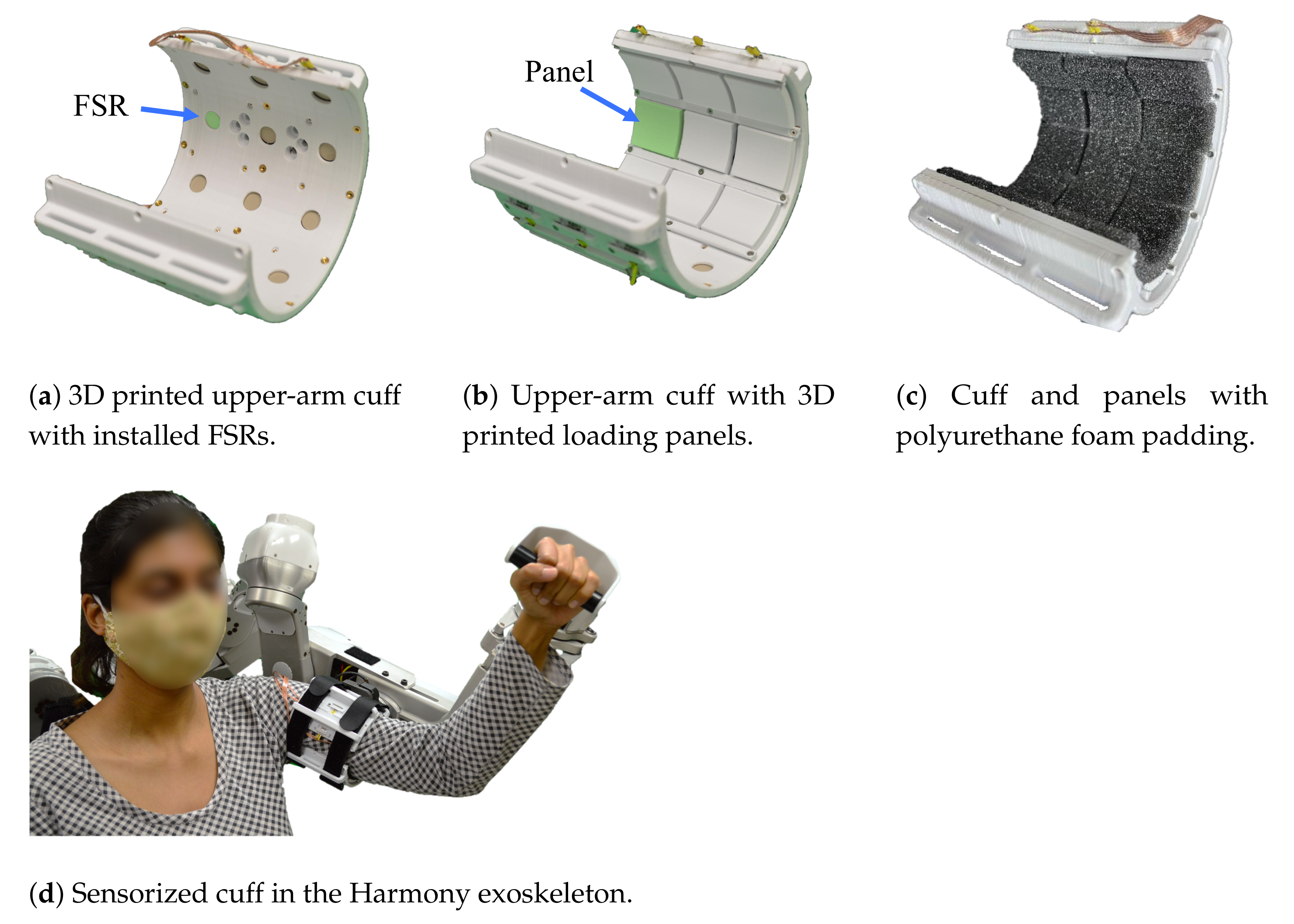
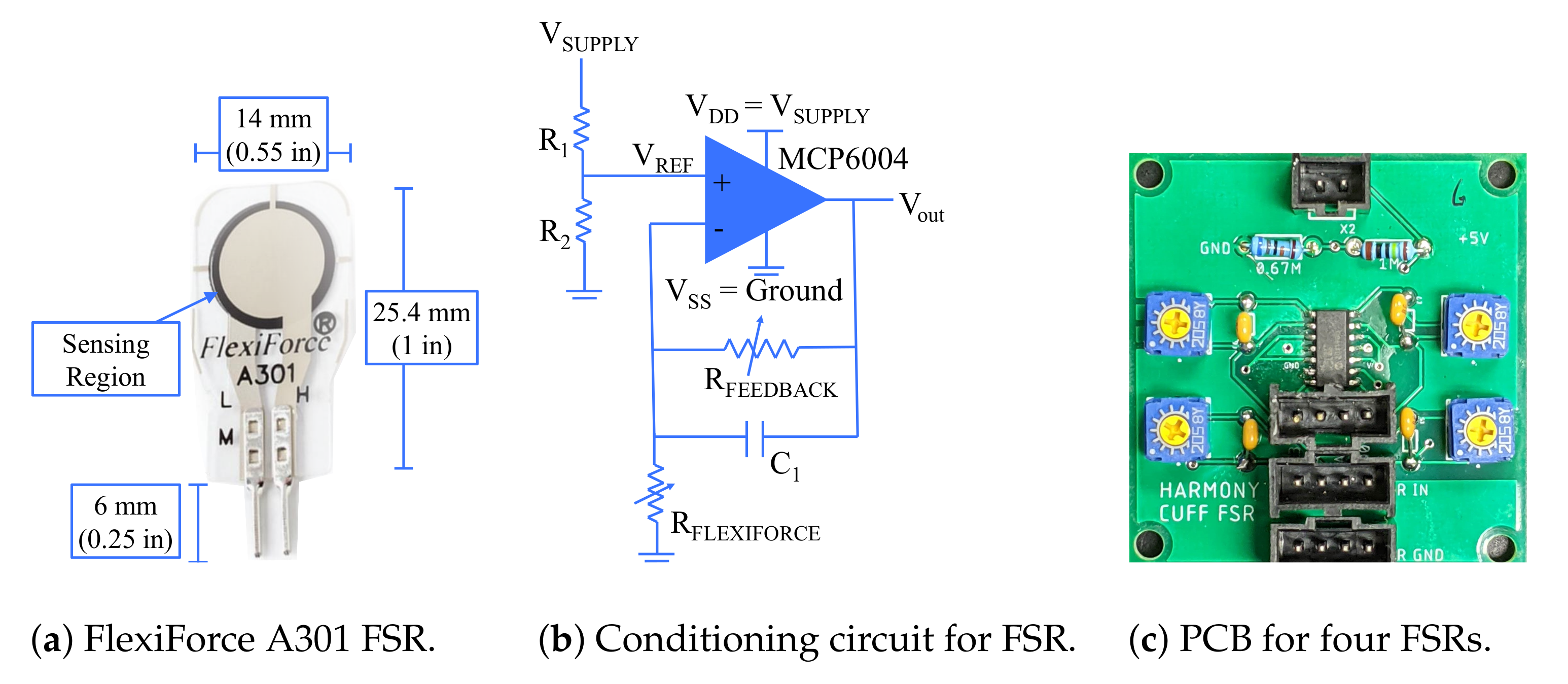

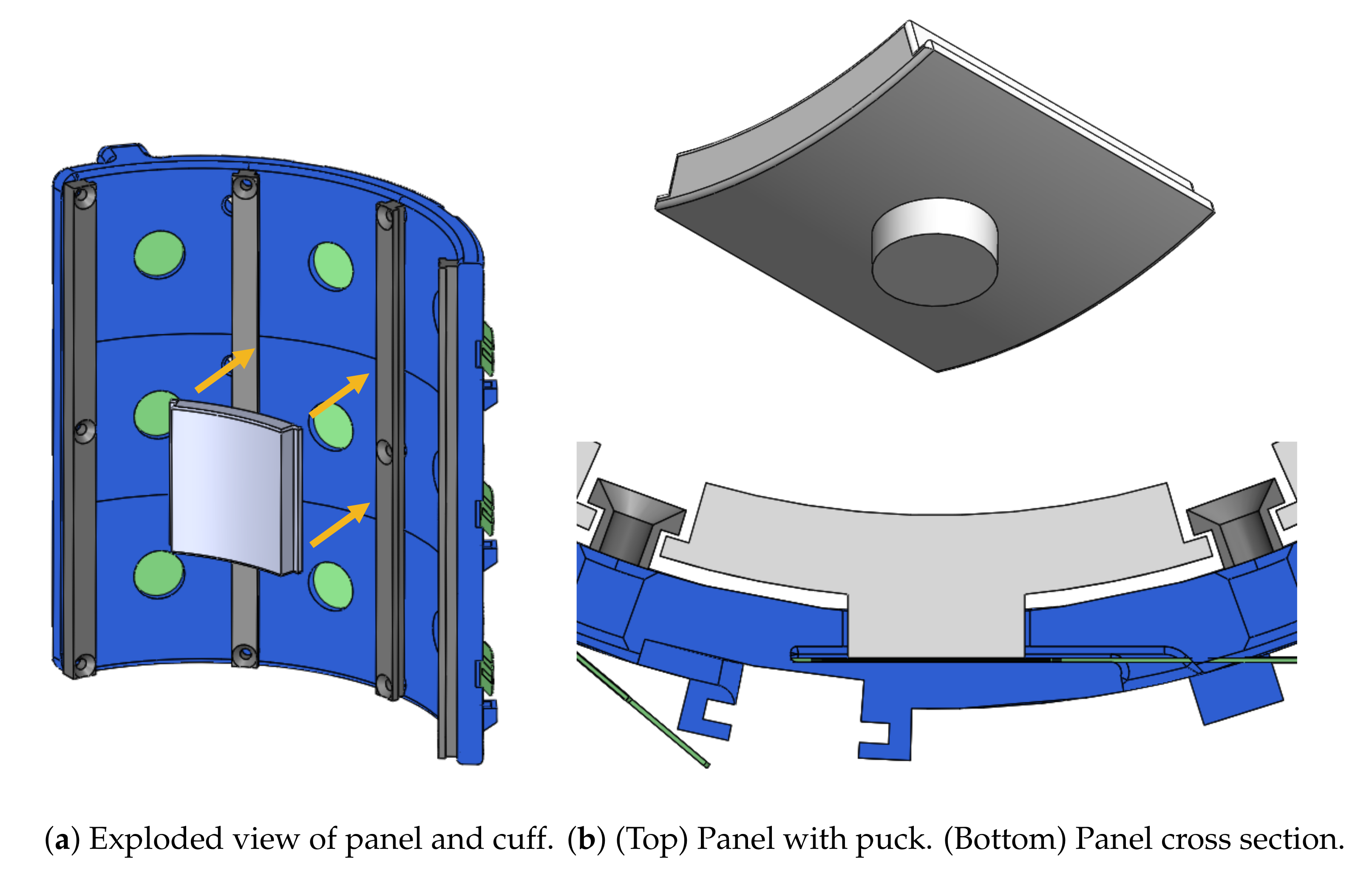
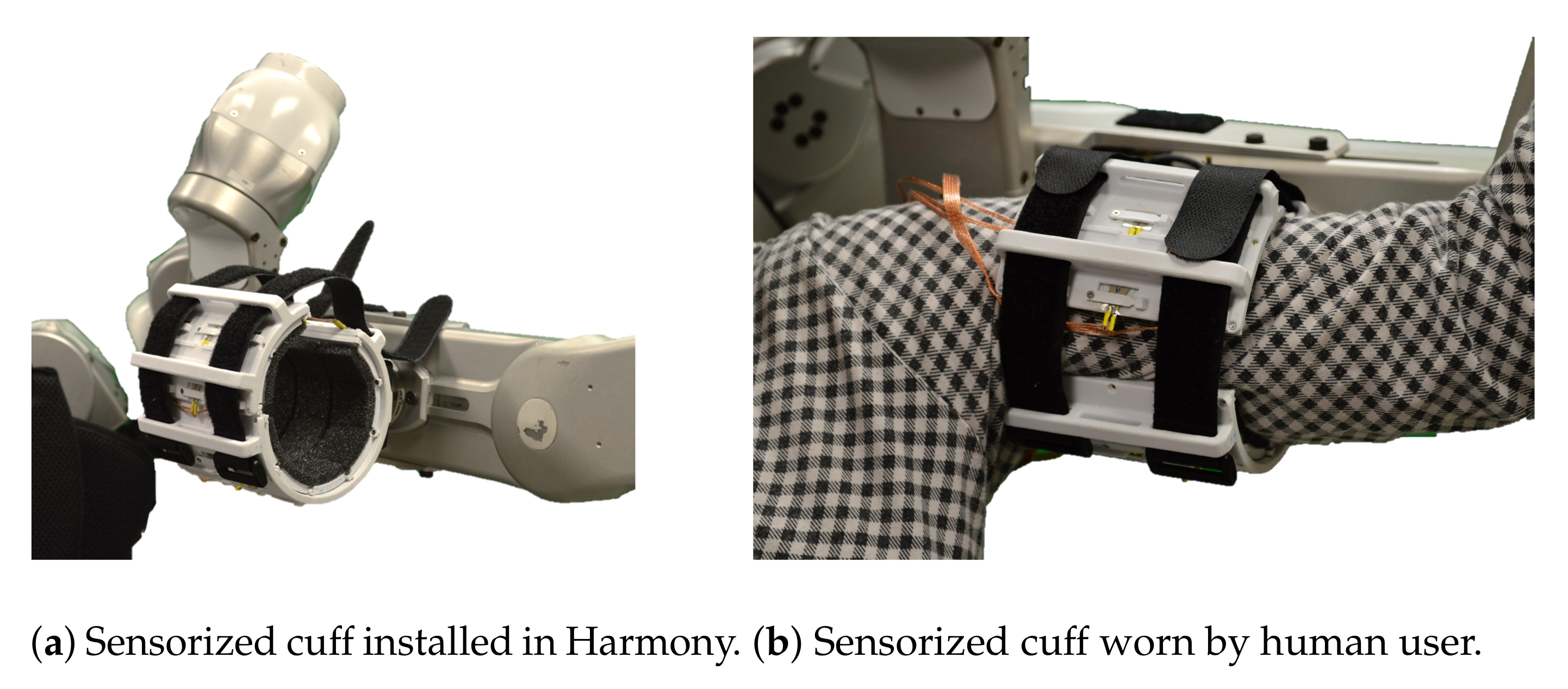
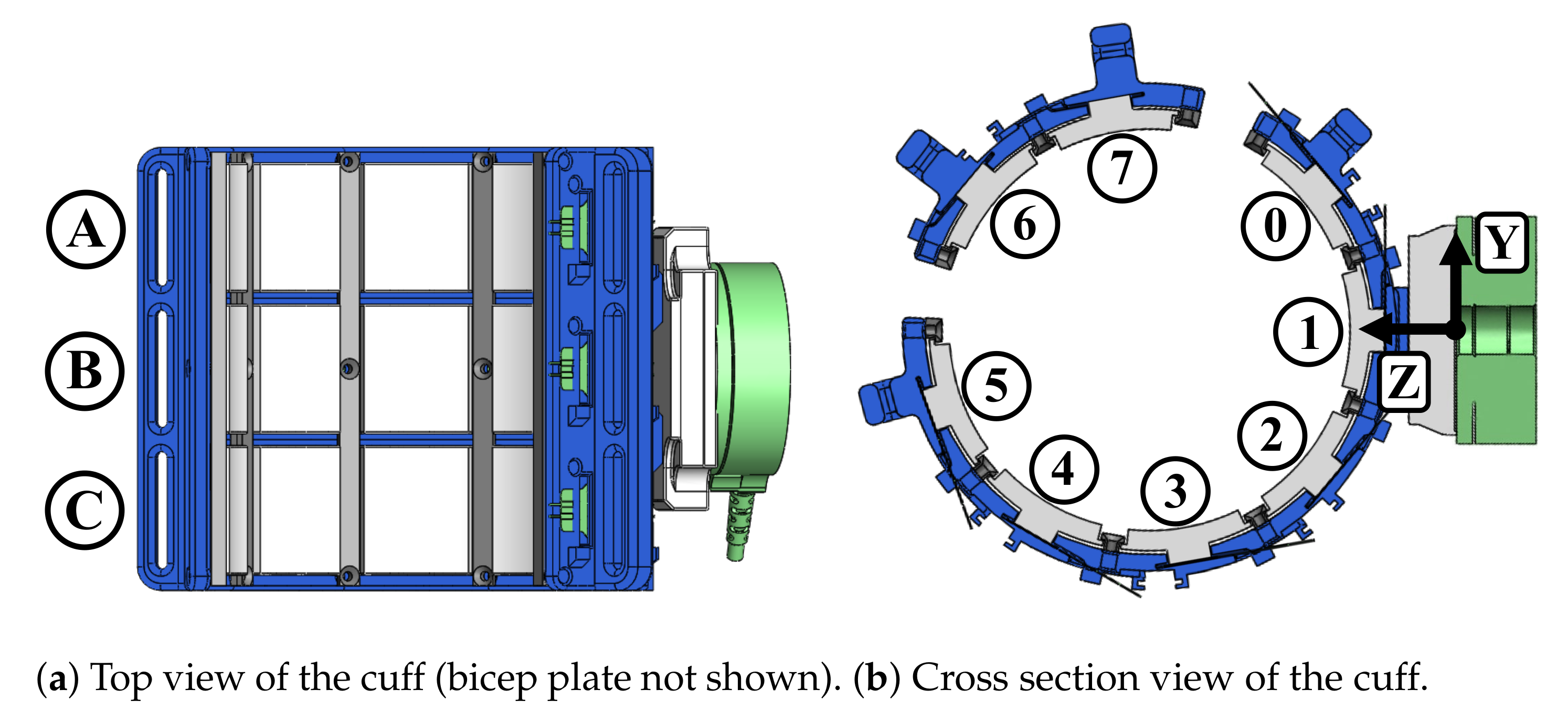
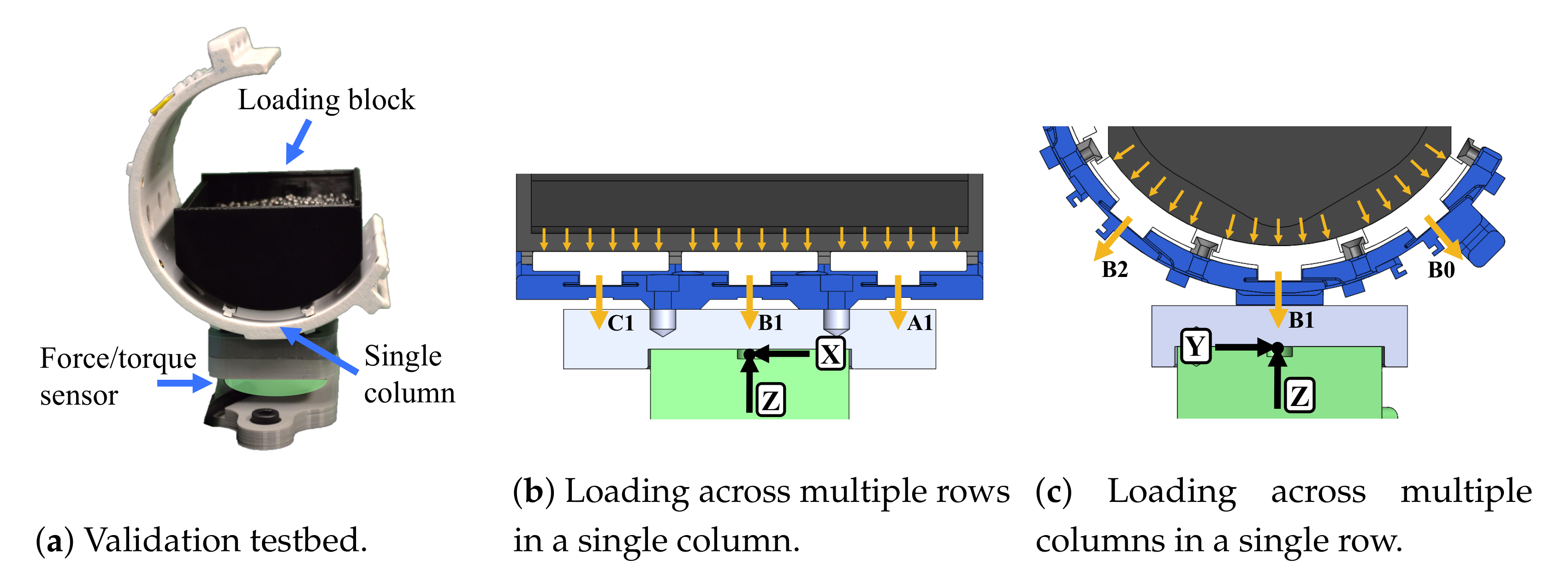

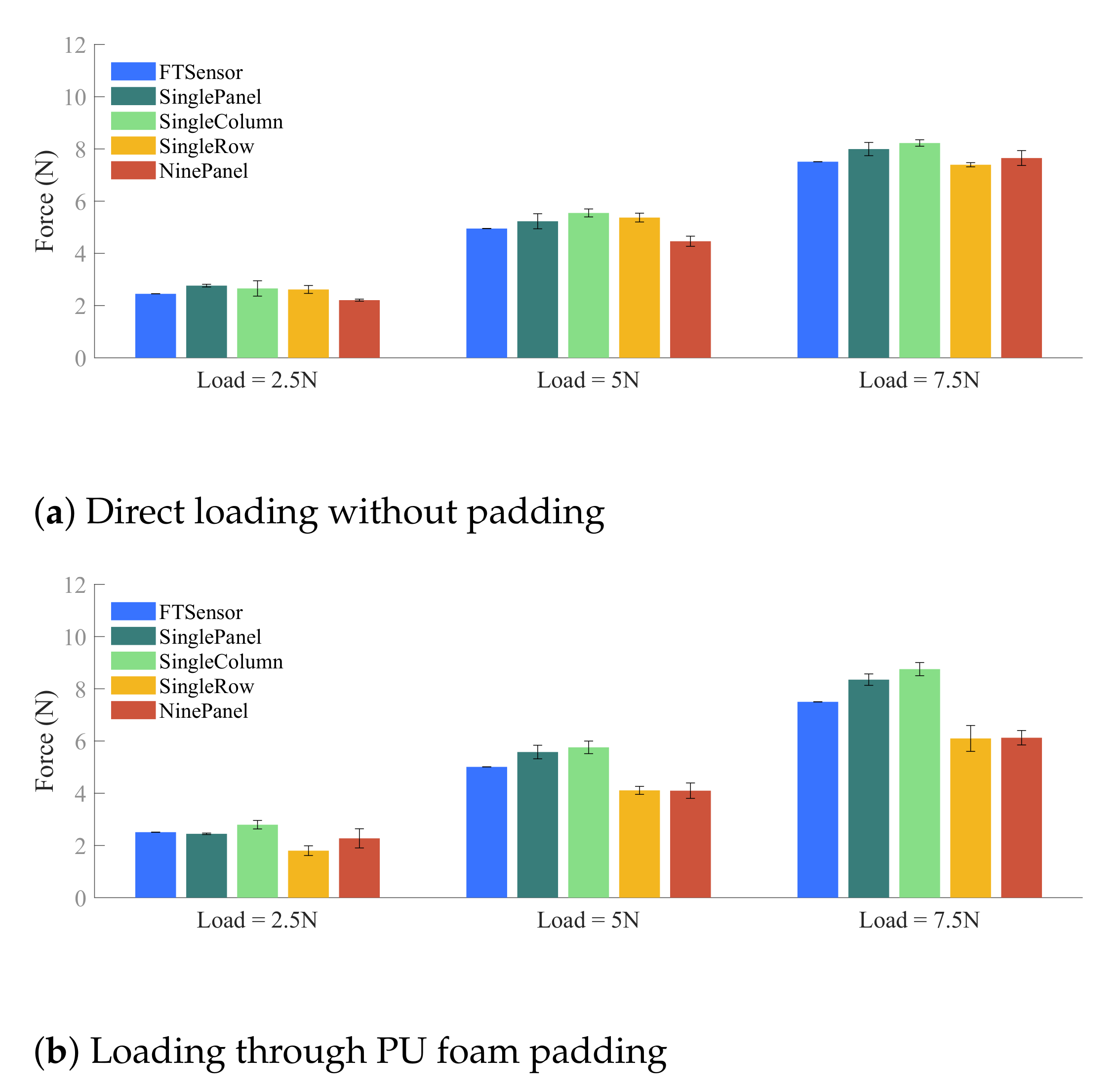
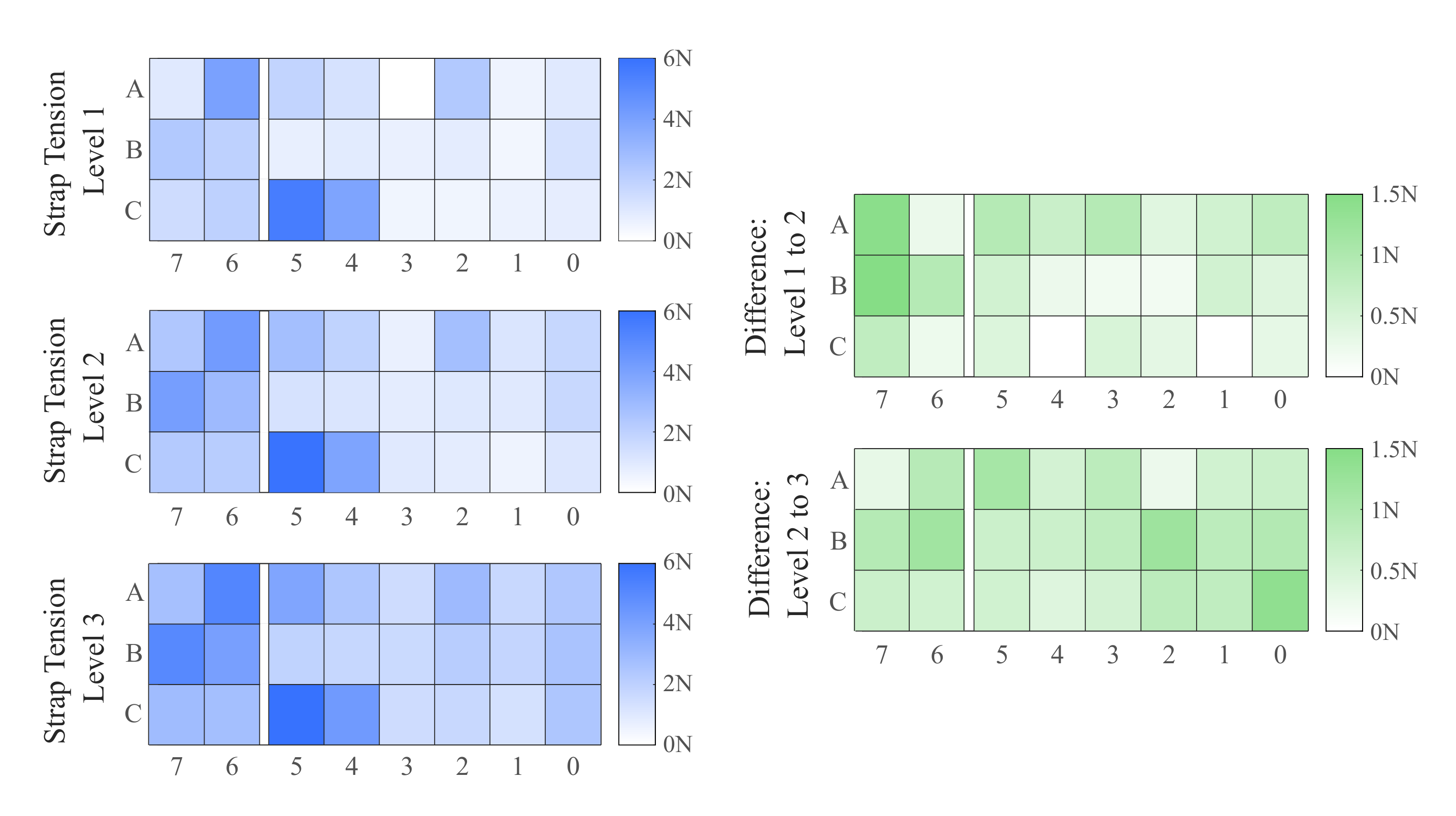
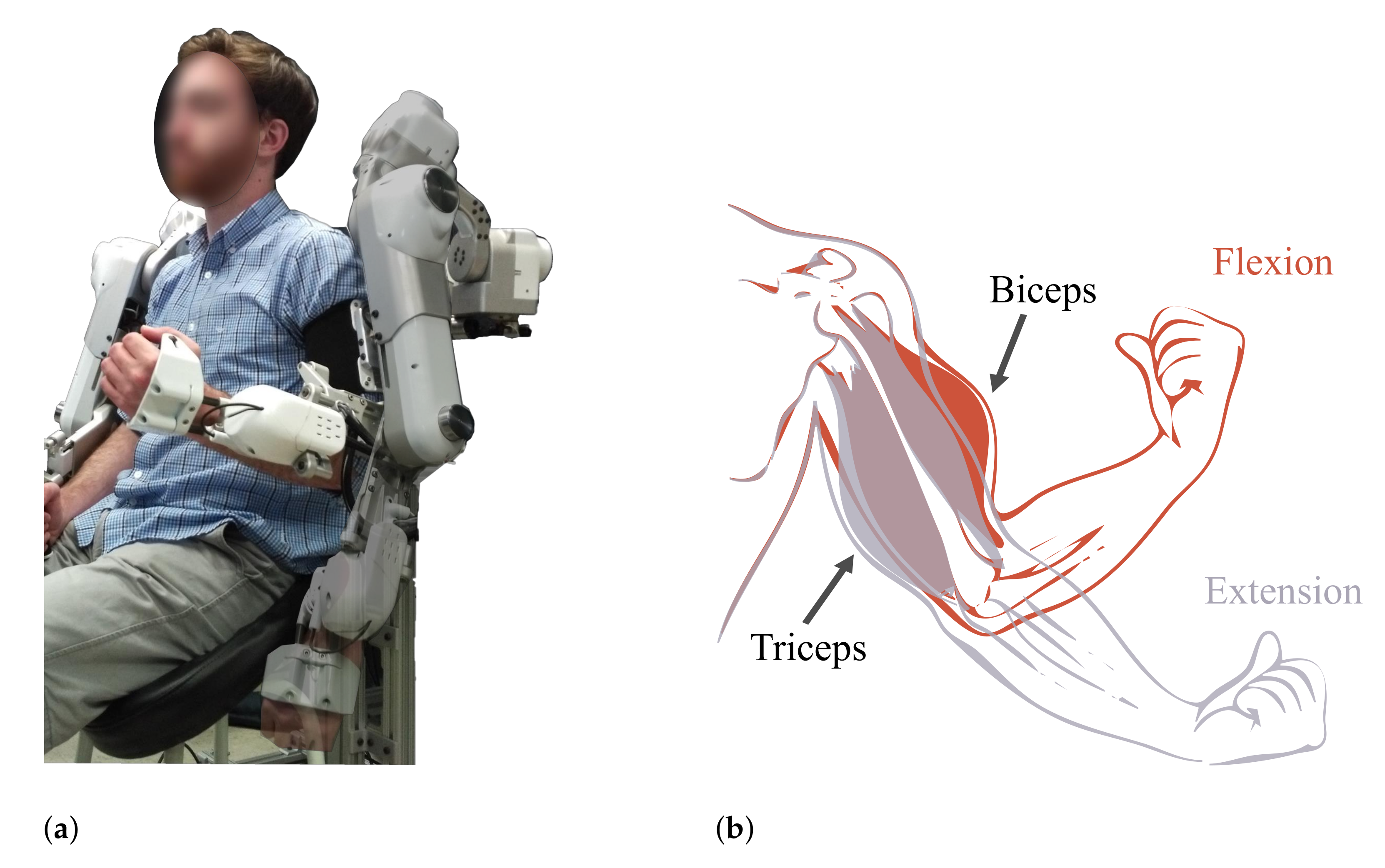
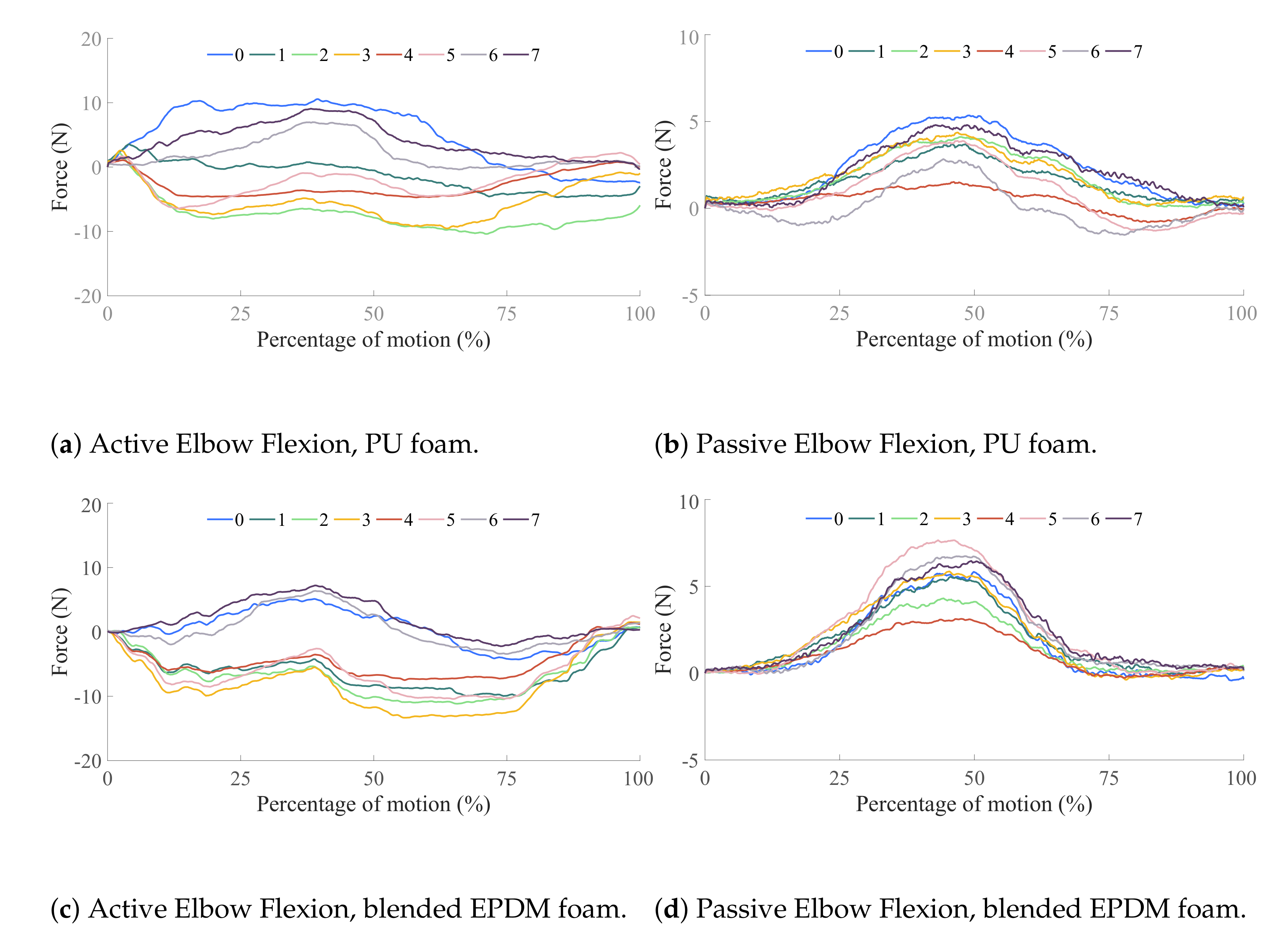
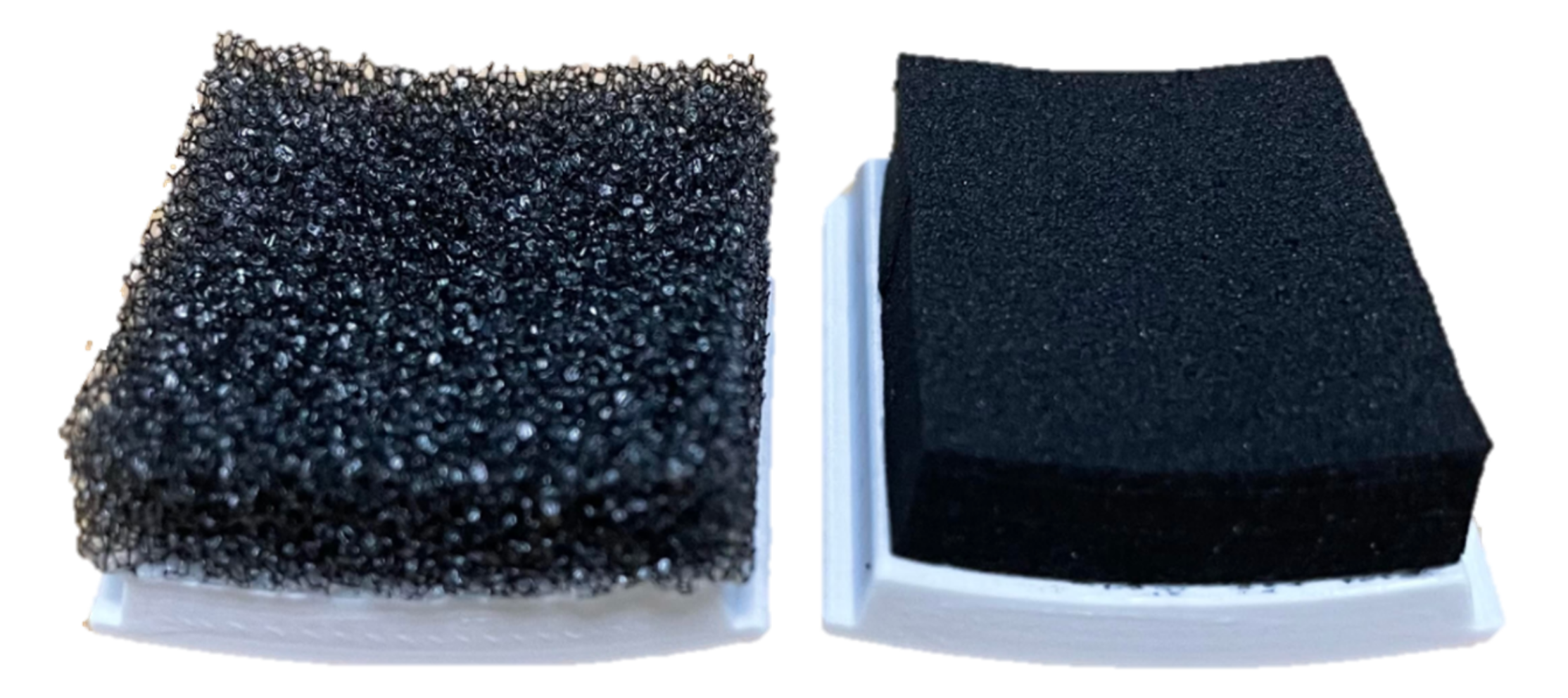
| Component Type | Name/Value |
|---|---|
| Operational Amplifier | MCP6004 |
| Capacitance | 15 pf |
| Power Source | 5 V |
| Resistance 1 | 1 M |
| Resistance 2 | 0.68 M |
| Potentiometer | 2 M |
| Direct Loading without Padding | Loading through PU Foam Padding | |||||
|---|---|---|---|---|---|---|
| Load = 2.5 N | Load = 5 N | Load = 7.5 N | Load = 2.5 N | Load = 5 N | Load = 7.5 N | |
| Single Panel | 2.76 ± 0.09 N | 5.23 ± 0.50 N | 8.00 ± 0.44 N | 2.45 ± 0.05 N | 5.58 ± 0.45 N | 8.35 ± 0.38 N |
| Single Column | 2.66 ± 0.51 N | 5.55 ± 0.26 N | 8.23 ± 0.21 N | 2.79 ± 0.28 N | 5.76 ± 0.42 N | 8.75 ± 0.74 N |
| Single Row | 2.62 ± 0.26 N | 5.37 ± 0.29 N | 7.39 ± 0.14 N | 1.80 ± 0.32 N | 4.11 ± 0.27 N | 6.10 ± 0.86 N |
| Nine Panel | 2.21 ± 0.07 N | 4.46 ± 0.34 N | 7.65 ± 0.49 N | 2.27 ± 0.64 N | 4.10 ± 0.51 N | 6.13 ± 0.48 N |
Publisher’s Note: MDPI stays neutral with regard to jurisdictional claims in published maps and institutional affiliations. |
© 2021 by the authors. Licensee MDPI, Basel, Switzerland. This article is an open access article distributed under the terms and conditions of the Creative Commons Attribution (CC BY) license (http://creativecommons.org/licenses/by/4.0/).
Share and Cite
Ghonasgi, K.; Yousaf, S.N.; Esmatloo, P.; Deshpande, A.D. A Modular Design for Distributed Measurement of Human–Robot Interaction Forces in Wearable Devices. Sensors 2021, 21, 1445. https://doi.org/10.3390/s21041445
Ghonasgi K, Yousaf SN, Esmatloo P, Deshpande AD. A Modular Design for Distributed Measurement of Human–Robot Interaction Forces in Wearable Devices. Sensors. 2021; 21(4):1445. https://doi.org/10.3390/s21041445
Chicago/Turabian StyleGhonasgi, Keya, Saad N. Yousaf, Paria Esmatloo, and Ashish D. Deshpande. 2021. "A Modular Design for Distributed Measurement of Human–Robot Interaction Forces in Wearable Devices" Sensors 21, no. 4: 1445. https://doi.org/10.3390/s21041445
APA StyleGhonasgi, K., Yousaf, S. N., Esmatloo, P., & Deshpande, A. D. (2021). A Modular Design for Distributed Measurement of Human–Robot Interaction Forces in Wearable Devices. Sensors, 21(4), 1445. https://doi.org/10.3390/s21041445








